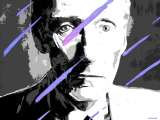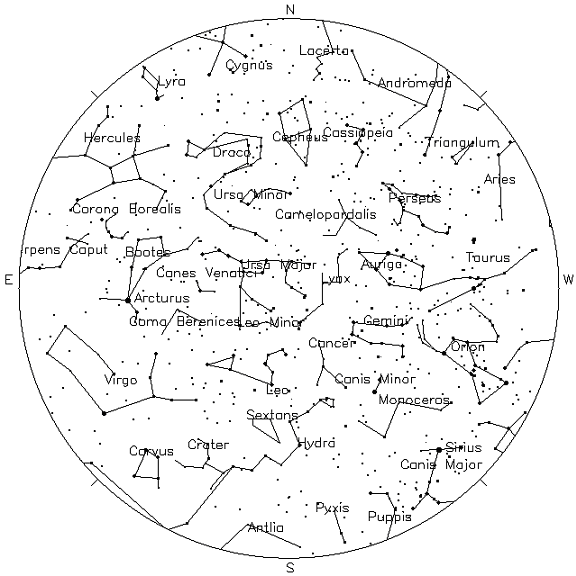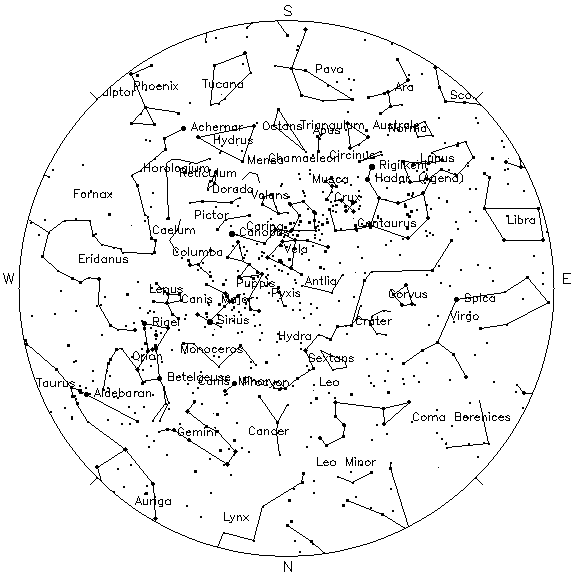 |
Old Bull Lee A Voice From the Reality-based Community Notes from a Study of Things Themselves |
 |
Using Celestial Navigation to Find Sweeney in Uruguay
Astronomical allusions piqued my interest in T. S. Eliot's poem "Sweeney Among the Nightingales" over forty years ago. I recognized "Orion and the Dog" as the brilliant winter contellation Orion, the hunter, and his companion, Canis Major, the dog. Interpreting the poem as a whole presented problems, though. I grasped that Sweeney, a regular sort of guy, is lounging in a cafe or brothel when he becomes fearful that two women are conspiring to do him harm. But what's the translation of the Greek epigraph? Why is Orion gloomy? And what does Agamemnon have to do with all this?
Recently I came across two enlightening references. The first was George Williamson's A Reader's Guide to T. S. Eliot: A Poem by Poem Analysis, published in 1953. Williamson devotes several pages to the poem, answering the questions that had lingered in my mind for so many years. Also, I found helpful notes posted online by Ian Lancashire of the University of Toronto at the Representative Poetry Online website.
Below is a stanza-by-stanza explication of Eliot's poem. Following that is an attempt to find the geographic location where the poem takes place based on hints in the text.
| Sweeney Among the Nightingales | "Sweeney Among the Nightingales" was published in 1920 in Ara Vos Prec. The character Sweeney appears in two other Eliot poems: "Sweeney Erect" and "Sweeney Agonistes." |
 |
The epigraph is taken from the Aeschylus play Agamemnon. The words are spoken by Agamemnon as he is fatally stabbed by his wife Clytemnestra. Williamson translates it as, "Aye me, I am smitten with a mortal blow!" |
|
Apeneck Sweeney spreads his knees Letting his arms hang down to laugh, The zebra stripes along his jaw Swelling to maculate giraffe. |
Sweeney is feeling animal spirits. "maculate" means spotted. |
|
The circles of the stormy moon Slide westward toward the River Plate, Death and the Raven drift above And Sweeney guards the hornèd gate. |
There is a River Plate (Plata) in South America, between Argentina and Uruguay. If this is the scene of the action, then Sweeney must be on the Uruguay side. Williamson says the "Raven" is the constellation Corvus. He doesn't say what "Death" means. I note that Hydra, the deadly serpent, is close to Corvus in the sky. Could it be that "Death and the Raven" refers to Hydra and Corvus? Perhaps horns or antlers are mounted above the door that Sweeney is sitting next to. Williamson tells us that the hornèd gate is the gate of lechery or death in Aeneid VI. Lancashire says that in classical mythology, dreams were said to emerge from such a gate. |
|
Gloomy Orion and the Dog Are veiled; and hushed the shrunken seas; The person in the Spanish cape Tries to sit on Sweeney's knees |
The "Dog" is the constellation Canis Major, which is close to the constellation Orion. The most prominent star in Canis Major is Sirius, sometimes called "the Dog Star." Sirius is the brightest star in the night sky. Williamson points out that in mythology the hunter Orion was murdered by a woman, Diana. |
|
Slips and pulls the table cloth Overturns a coffee-cup, Reorganised upon the floor She yawns and draws a stocking up; The silent man in mocha brown Sprawls at the window-sill and gapes; The waiter brings in oranges Bananas figs and hothouse grapes; The silent vertebrate in brown Contracts and concentrates, withdraws; Rachel née Rabinovitch Tears at the grapes with murderous paws; She and the lady in the cape Are suspect, thought to be in league; Therefore the man with heavy eyes Declines the gambit, shows fatigue, Leaves the room and reappears Outside the window, leaning in, Branches of wistaria Circumscribe a golden grin; |
Williamson says that the "silent man in mocha brown," "the silent vertebrate in brown," and "the man with heavy eyes" are all Sweeney. Sweeney, sleepy or drunk, senses danger. He feels threatened by the two women and leaves the room. Once outside he leans in, through the window. |
|
The host with someone indistinct Converses at the door apart, The nightingales are singing near The Convent of the Sacred Heart, And sang within the bloody wood When Agamemnon cried aloud, And let their liquid siftings fall To stain the stiff dishonoured shroud. |
From the outside, Sweeney surveys the scene inside. Williamson ventures that "someone indistinct" is the agent of Sweeney's fate, i.e his potential murderer. Sweeney becomes aware of nightingales singing nearby. The birds remind him of Agamemnon's ignominious death, a fate he has so far avoided. Lancashire observes that in Sophocles' play Oedipus at Colonus there is a grove of trees, occupied by the classical Furies, where nightingales sing and bloody events take place. Also, he notes that in Ovid's Metamorphoses there is a wood where Tereus raped and mutilated Philomela, who was later turned into a nightingale. |
Where is Sweeney?
There are four clues as to the location where this poem takes place.
- It is east of the River Plate.
- The constellation Corvus is high in the sky, maybe overhead.
- The constellations Orion and Canis Major would be visible if not obscured ("veiled") by clouds.
- The presence of "shrunken seas" suggests the action takes place near an ocean, where tidal ebb and flow would be observed.
We might suspect the poem takes place in England, the author's home. England could satisfy the fourth clue, but we would have to presume there is River Plate in England or that the River Plate is fictional or imaginary. The second clue, however, rules out England as a possibility: the constellation Corvus is never high in the sky in England. In the best of circumstances, Corvus and Canis Major appear low on the southern horizon when viewed from England's latitude.
The Fourmilab website provides a software tool, called Your Sky, that shows where constellations appear in the sky based on (1) the geographic coordinates of the observer, (2) time-of-day and (3) day-of-year. All constellations visible are shown inside of a circle, where the circumference of the circle represents the horizon and the center of the circle is the zenith.
If we assume the action of the poem takes place at 9 pm local time, we can adjust the day-of-year experimentally to find a date when the three constellations can be seen optimally from any chosen location. That date is about April 1.
The diagram below, contructed with Your Sky, shows how the constellations would appear from London on April 1 at 9 pm. Corvus "the Raven" is very low on the horizon, as is Canis Major, "the Dog."

Montevideo, Uruguay satisfies all the necessary conditions. It is east of the River Plate, near the Atlantic coast. The three constellations mentioned (see below) would be high in the sky on April 1 at 9 pm.

So, did Eliot intend for Sweeney to be in Uruguay? Had Eliot ever seen the night sky in Uruguay? Did Eliot have any idea about the relative celestial positions of the constellations Orion, Canis Major and Corvus?